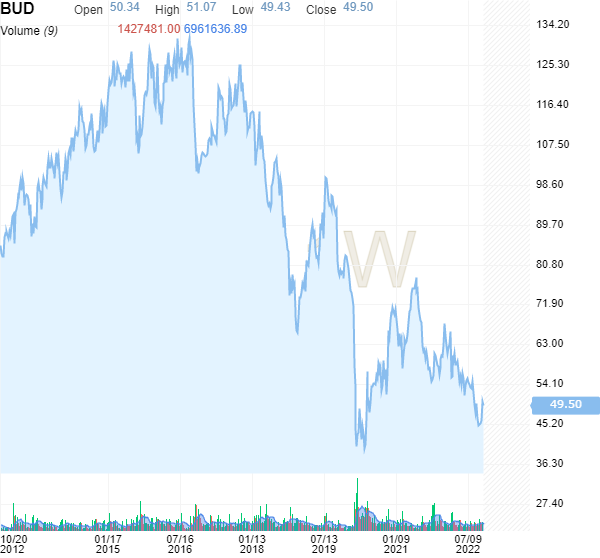- With profit growth returning in 2022, and a reasonable valuation, BUD seems like it could be a buy
- But the comparison is somewhat easy, and the multi-year trend remains negative
- ABI needs to show consistent growth before stock gets truly attractive
Over the past few years, Anheuser Busch Inbev (NYSE:BUD) has been one of the worst large-cap stocks in the entire market:

BUD stock has plunged 64% from 2017 highs. The cause of the sell-off is simple. AB InBev is a heavily indebted company whose profits simply stopped growing. In 2017, the company generated $22.1 billion in normalized EBITDA (earnings before interest, taxes, depreciation and amortization). Four years later, the figure was $19.2 billion.
That decline created a quadruple whammy for the stock. First, the multiple to EBITDA investors were willing to pay came down: profits from a declining business are worth much less than those from a growing one.
Second, actual EBITDA came down. And so the value investors would ascribe to the entire business declined at an even faster rate than did profits.
But, of course, BUD stock does not represent a claim on the entire business, only the equity. And the debt on the balance sheet — AB InBev had more than $100 billion in borrowings at the end of 2017 — remains unchanged. And so AB InBev’s enterprise value fell faster than profits, and its market capitalization declined even faster than that. To top it all off, disappointing free cash flow meant less ability to repay debt going forward.
In that context, the 60%-plunge in BUD is no surprise. But it also might — emphasis on ‘might’ — create an opportunity.
After all, the same mechanism works in reverse. That’s not to say BUD has an easy path back to $130-plus, but if the company can start generating growth, there’s room for the stock to recapture a significant amount of what it has lost to this point.
Right now, AB InBev is generating growth. The question is if it’s enough.
The Case For BUD Stock
It looks like AB InBev is back on track. After third-quarter earnings last week, the company raised its full-year guidance for normalized EBITDA to 6-8% growth. Volume sold increased 3.7% year-over-year.
In the context of the external environment, that performance appears exceptionally impressive. As an analyst noted on the third-quarter conference call, Budweiser’s second largest market is China, which is dealing with numerous shutdowns related to the novel coronavirus pandemic.
Inflation is pressuring consumers worldwide. Macroeconomic growth has slowed. Input costs have increased. The thought might be that if AB InBev can grow profits in this environment, it can do so going forward as well. Indeed, that’s what the company’s management is saying: AB InBev is guiding for 4% to 8% normalized EBITDA growth going forward.
And, at this point, even that modest growth is enough to make BUD stock a winner. It allows the company to continue paying down debt; it’s already deleveraged to the tune of more than $20 billion in the last four-plus years. Meanwhile, with BUD trading at 16x this year’s earnings and less than 9x EBITDA, not all that much growth is priced in.
How Good Has 2022 Been?
All that said, it’s perhaps a little too early to pile into the stock just yet, for a pair of reasons.
The first is that even with current challenges, the prior-year comparison remains a bit soft. The 2021 results suffered from pandemic lockdowns, particularly in the early half of the year. Its Q3 results saw potential strength in many Latin American countries — where the pandemic recovery was slower, and 2021 results in some cases remained depressed.
The second reason to be cautious is that even growth in 2022 leaves BUD down on a multi-year basis. (This, too, goes to the idea that comparisons aren’t particularly difficult — yet.) The midpoint of guidance suggests roughly $20.5 billion in normalized EBITDA, down about 7% from the level reached five years earlier.
To some extent, what AB InBev has done to this point is the easy part. It’s stemmed the proverbial bleeding. Stabilization has begun. But it’s also done so at a time when smaller brewers are more susceptible to the inflationary impacts being seen worldwide.
From here, the hard part really begins. AB InBev has to continue to drive premium sales growth in developing markets, which drove 58% of revenue last year (albeit a smaller share of profit). It has to combat the continued growth of craft beer in developed markets, notably in the U.S., which has steadily eroded Budweiser’s market share.
It has the ability to do so. Products like Bud Light Seltzer and Cutwater ready-to-drink cocktails have shown growth potential. Michelob Ultra is rolling out worldwide. Craft beer may have reached saturation in the U.S. and Europe.
There’s certainly an argument to buy BUD now, and bet on this growth continuing. Investors simply need to understand the bet they’re making, and the risks involved.
Disclaimer: As of this writing, Vince Martin has no positions in any securities mentioned.
